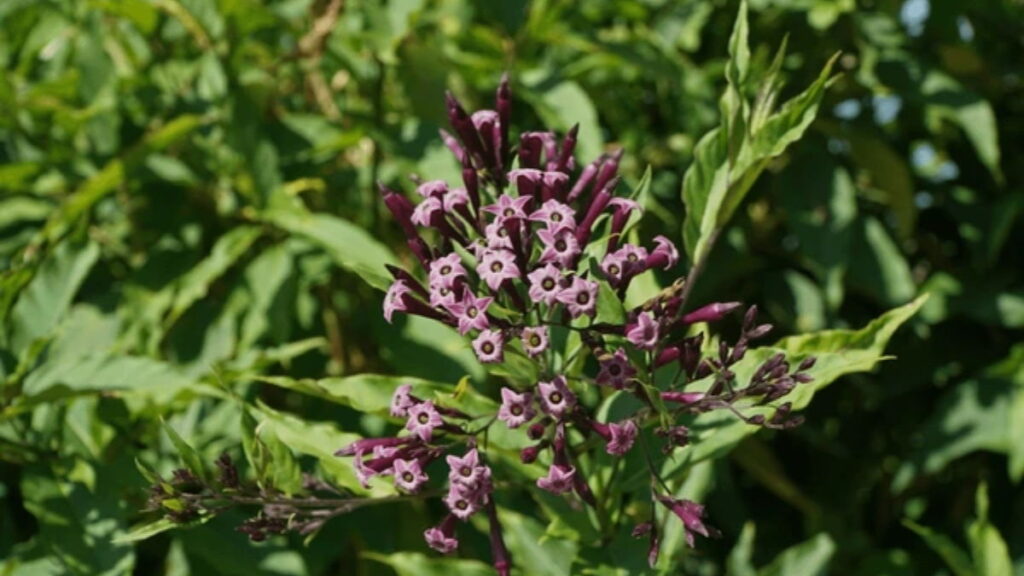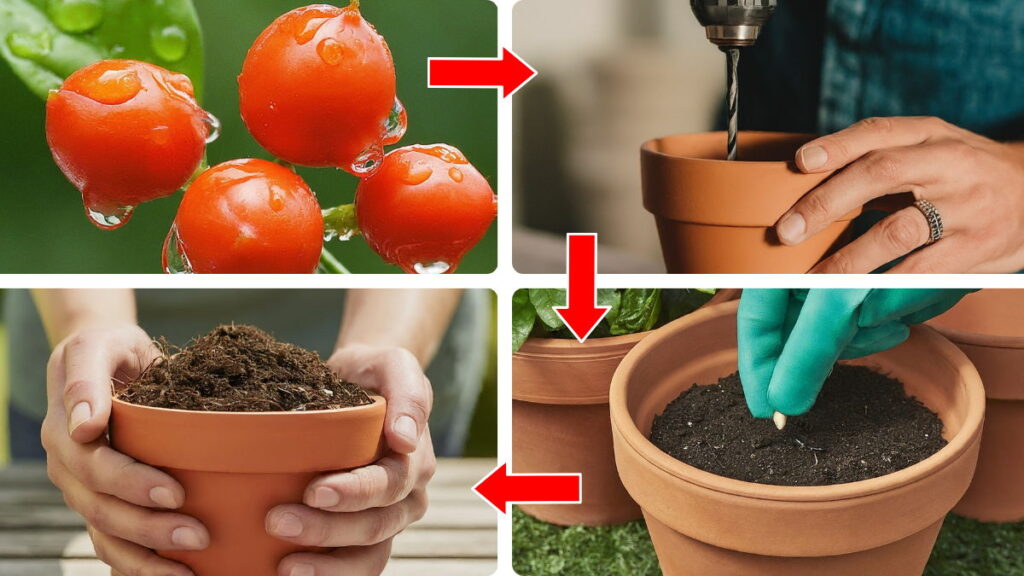Purple jasmine is an ornamental evergreen plant that belongs to the Solanaceae family, and in ideal conditions, it can grow up to a height of 7 ft. Purple Cestrum is also known as Bastard jasmine and has a delightful sweet smell. Purple jasmine thrives well in partially shaded environments and starts blooming its beautiful purple flower from August till March.
It also produces small dark red berries. It is a drought-tolerant plant that needs fertile and loose soil, and bastard jasmine flowers attract pollinators like hummingbirds and bees. If you have four-legged friends or babies at your home, you must pay attention to them when they are near the plant because all the parts of purple jasmine are toxic if ingested.
It grows well in warm, tropical areas rather than cold, frizzy climates. You can find them in Florida, south California, and Florida. Purple jasmine can quickly adapt to USDA zone 9 and tolerate -7 C temperature.
You can train purple jasmine to grow on pillars. These plants will also create mesmerizing foliage as a wall shrub, and on the patio or the terrace and balcony, you can grow them in hanging baskets as ornamental plants. But to get the optimal look, grow them in a large pot or container and train them to climb on trellis, pillars, or poles.
| Binomial Name | Cestrum Elegans |
| Common Name | Bastard Jasmine, Purple Jasmine |
| Family | Solanaceae |
| Genus | Cestrum |
| Species | C . Elegans |
| Soil | Well Fertilised & Loose Soil |
| Sunlight | Partial Shade or Full Sunlight |
| Water | Moderate watering and known for its drought-tolerant properties |
| Blooming Season | Blooms cluster of flowers in August – March and then starts reblooming from May till October |
| Toxic | All parts of the plant are poisonous. |
| Leaves | purplish shade and have an unpleasant smell |
| Fruit | Small and of red color |
| Flower Color | Red flowers bloom in tubular shape |

Purple jasmine does not demand something extra from your side, just like other plants; it also has some basic requirements to develop healthy stems and roots and give gorgeous blooms. You have to plant them in well-draining soil, and they demand medium watering. But what if the plant you purchased from your local nursery is unhealthy? Choosing a healthy plant with strong roots is very important, so here’s a checklist to buy a healthy plant, and all your time and money will be worthwhile.
Checking the leaves
While buying a plant, if you are witnessing yellow, brown, or wilted leaves, it might be affected by some disease or fungal or bacterial infection. Healthy, bright leaves are the sign you are looking for.
Checking the Plant For Pests
Check for pests and their symptoms under the leaves and in the roots. Avoid buying pest-ridden plants from the nursery to enjoy a stress-free gardening experience.
Checking for weeds
Check for the weeds in the plant’s soil because weeds suck up the nutrients from the soil that should be absorbed by your plant, making the plant weak.
Checking For Healthy Roots
Plant roots tell the story of the whole plant; closely inspect the plant roots, and you will understand the plant’s health after touching the root of the plant if it feels soggy or soft and is of brown color or after the roots are breaking then this is not the plant you are looking for also avoid purchasing root bound plants.
Checking for leggy plants
When a plant doesn’t receive enough sunlight or is over-fed, it develops unnatural long stems with few leaves. It’s a sign of weakness, and these plants are at high risk of getting a disease.
Purple Jasmine Care Tips

Plant care plays a significant role in deciding the future of plant health and its growing nature. Purple Jasmine is an easy-to-care plant that requires little effort; it can transform your space into a blooming paradise. The proper knowledge about plant care – its placement, soil preparation, watering routine, feeding at the right time, and timely pruning is the key to maintaining a healthy and thriving plant. After all these, you can expect lush and vibrant foliage full of purple jasmine-scented flowers.
Soil
For bastard Jasmine, you must prepare a well-draining, fertile, loose soil. The soil pH should be 6.0 – 7.5, slightly acidic to neutral. You can make potting mix at home by mixing soil, sand, vermiculite, and coco peat for the aeration, or you can purchase it from your local plant or nursery. Purple Jasmine struggles to thrive in soggy soil, and in the worst case, it can lead to root rot, and all your efforts will go in vain.
Plants Placement Or Sunlight
Purple Jasmine requires 5-6 hours of daily sunlight and can thrive when planted in partial shade. If you live in a region with extreme summer heat, growing your Jasmine in partial shade is better. It will prevent your plant from getting sunburned if you have planted your bastard jasmine in a pot or container and then brought it back indoors during winter.
Watering
Unlike all other plants in your garden that need to be showered daily, purple Jasmine is equipped with drought-tolerant capabilities, and it wants to be watered once a week; giving it water in moderate amounts is beneficial for their health and will lower the chances of getting waterlogged.
Feeding
It’s best to fertilize your Cestrum Elegans with a slow-releasing balanced fertilizing tablet during its growing period, and when its blooming period is about to start, you can also feed them in spring if your soil mix lacks nutrients. You can also use homemade fertilizer with a banana peel. It will provide phosphorus and potassium essential for plant growth, or you can use eggshells to feed your purple Jasmine. It contains calcium, which is necessary for its root development.
One tip for you when fertilizing your plant: muddle the upper layer of soil so the soil becomes loose and fertilizer can quickly dissolve into the soil.
Pruning
Pruning your plants helps them grow new branches, making their foliage lush. Always use a sharp and sterilized shear for pruning, and try to prune branches at a 45-degree angle that will lower the chances of stem rot. Always prune your purple jasmine plant after it stops rewarding you with gorgeous flowers.
Propagation Tips For Purple Jasmine
I will discuss three propagating techniques that will help you double your bastard jasmine plant—propagating through seeds, cutting, and layering.
Propagating Through Seeds
Propagating plants through seeds is the simple method to double your purple Jasmine, but you must wait longer to get those alluring scented blooms. You can easily collect berries from a developed plant for propagation. You can also purchase the seed from any online store or local nursery. Make sure that your seeds are of the best quality. The quality of the seeds is going to decide whether they will germinate or not.
Steps to follow

- Wash the berries of purple jasmine plants and extract the seeds.
- Then, soak the seeds overnight so that they can germinate quickly.
- Now, prepare a pot and make a small drainage hole at the bottom of the pot or container. Fill it with potting mix or your prepared well-draining soil mix.
- Now sow the seed and pour some water from the top; moderate watering is suggested so the soil will not become soggy. It will increase the chances of seed rotting. Always check the upper layer of the soil with your fingers; only water if it feels dry.
- To increase the seed germination process and the plant’s growth, place the plant in an area where it can get the morning sunlight. After 2-4 weeks, the seedlings appear from the soil.
Propagating From Cuttings
Purple Jasmine is an easy-to-grow plant from its cutting if taken from a healthy plant. Afterward, you can vitalize its roots and grow a beautiful blooming plant. It will fill your outdoor garden with its sweet, aromatic blooms.
How To Take Cutting From A Purple Jasmine Plant

- Look for the new, flexible, healthy stems that grew almost a year ago. How do you check that? It will look green with fresh leaves and be semi-hard. If it is mature enough, you can take 2-4 cuttings from the same plant; it will boost the chances of doubling your plant from cutting.
- Using Sharp shears for cutting will ensure that the cut is clean. Spot a leaf node and make a 4-6 inches long cut. Don’t cut the stem that is still blooming flowers.
- Leaving the top leaves attached to the plant to remove the lower leaves of the stem will maintain the equilibrium of the development of the roots and leaves.
- If your stem has any flower deadhead, the flower from your cutting because the flower requires nutrients, and it will suck the nutrient from the cutting.
- Prepare a pot or container with a draining hole and fill it with a nutrient-rich potting mix. You can plant more than one cutting in the same pot and separate the cuttings after the development of roots.
- Now sprinkle the water on the soil to retain some moisture.
- Use any pen or pencil to make holes where you will plant the cuttings.
- Purchase rooting hormone from your local plant store. It is available in gel or powder form and encourages root growth in plant cuttings.
- Now, take some rooting hormone in a clean container, dip the stem’s end part into it, plant the cuttings into the holes, and gently press the soil around it so it can’t move. I will not recommend directly dipping the stem into a bottle, as that will damage the entire product.
- Now pack the container with transparent plastic to keep the cutting moist; only open the plastic to water the cutting. Place the pot in a location where it can get enough sunlight.
- After 4-6 weeks, the root will start developing into the cutting, and now you can transfer the plant into a new pot or container.
Layering
This is the last method I recommend for propagating purple jasmine plants, but this process is not for greenhorn gardening enthusiasts. Layering can be done in many ways, like simple layering, tip layering, serpentine layering, and mound layering. However, my favorite is Air Layering, which can be done on any plant. But for vining plants, I will suggest simple layering, compound layering, or serpentine layering.
Simple Layering
You have to bend a low-growing purple jasmine vine to the ground and cover the bent part of the vine with soil. Use something to hook it under the ground, leaving 6-12 inches of the tip above the ground. After 4-5 weeks, the vines bent under the soil and grew roots.
You can easily do simple layering in the spring or late summer. It may take more than one growing season to develop strong roots so that you can transform it somewhere else.

Compound Layering
It is the same as simple layering, but in this method, you can make several layers from a single stem by bending the stem alternately, leaving one bud above the ground and one bud under the soil.

Conclusion
Purple Jasmine is a fantastic yard, patio, or balcony garden plant. It will add charms to your space, spreading the beauty of its scented aromatic blooms. I have discussed all the major factors for growing, caring, and propagating this stunning plant here. So, if you love Jasmine, it is a must-have addition to your garden.


1 thought on “Purple Jasmine – Cestrum Elegans Care And Propagation ”